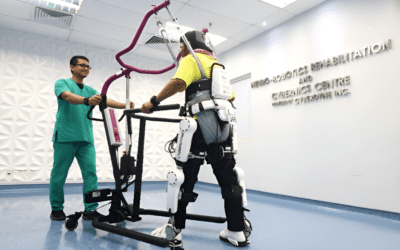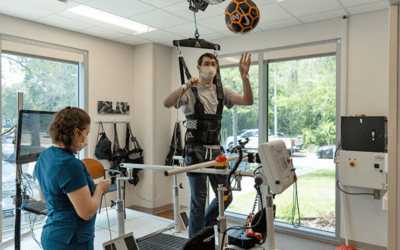Using VR to create engaging and challenging situations may help you stay focused and engaged in your rehab, and it may help your PT find new ways to challenge your body for you to improve movement and strength. Common orthopaedic conditions that may benefit from the use of VR may include ankle sprains.
Can virtual reality devices be used in a rehab setting?

Why use VR versus other forms of physical therapy? Can using VR help you achieve your rehab goals, or is it just a novelty?
Sometimes taking a novel and fun approach to care is a good way to stay engaged in your rehab programme. You are more likely to be motivated during your rehab if it is fun. Virtual reality rehab may be just the thing to motivate you to participate in physical therapy.
There are several instances where virtual reality headsets and devices can be used in physical therapy. People with various diagnoses might be able to benefit from its use.
Advancements and applications of Virtual Reality in Neuro Rehab
- Neurological Conditions:
People with neurological conditions may have impairments in the arms that make reaching difficult, and lower extremity impairments may make balance and walking challenging. Using VR may be an effective and engaging way to improve upper or lower extremity coordination and balance during physical therapy.
Neurological diagnoses that may benefit from the use of virtual reality in physical therapy may include Multiple sclerosis, Parkinson’s disease, Spinal cord injury, etc. Any neurological injury that causes difficulty with normal movement may benefit from the use of VR in physical therapy.
- Vestibular Rehabilitation:
The vestibular system works to coordinate a patient’s head movements and positions with eye movements. Sometimes, an impairment in the vestibular system may cause vertigo and difficulty maintaining an upright position. Often, stabilisation exercises are done to help the body relearn the proper head and eye movements that are required to maintain upright positions.
Virtual reality headsets may be used to create situations that challenge the visual system while you are in vestibular rehab. Videos of roller coasters, swooshing cars zipping by, or optokinetic shapes may be projected in front of your eyes while you are working to maintain an upright balance.
This challenges your visual input and nerves that help you stay upright, working to strengthen the necessary bonds between your vestibular organs and eye movements.

- Orthopaedic Conditions:
If you have shoulder pain and have a difficult time reaching, you can enjoy a physical therapy session with a virtual reality device. While wearing the VR headset, a video may be displayed that requires you to reach overhead in various directions.
Or you may have balance problems after an ankle sprain or knee surgery. Using VR to create engaging and challenging situations may help you stay focused and engaged in your rehab, and it may help your PT find new ways to challenge your body for you to improve movement and strength.
Common orthopaedic conditions that may benefit from the use of VR are:
- Ankle sprains
- Shoulder pain and impingement
- After ankle, knee, or hip surgery
- Neck pain, back pain, and associated radiculopathies
Any orthopaedic injury that creates an impairment that limits your functional mobility may benefit from the use of virtual reality during rehab.
- Paediatric Conditions:
Physical therapy is hard work, but for children, this work is often done through play. Finding novel ways to incorporate play activities into rehab may be key to getting proper functional movement. Using VR technology may be just the key to keeping a child engaged in the work of rehab while correcting movement impairments.
Conditions that may benefit from VR use in children are:
- Cerebral palsy
- Attention deficit disorder
- Developmental delay
- Autism
If a child is experiencing impairments that limit functional mobility, then they may benefit from physical therapy. And if a novel and playful instrument is needed to fully engage that child in rehab, then VR may be just the tool.
Advancements in Virtual Reality (VR) immersive technologies provide new tools for the development of novel and promising applications for neuro rehabilitation.



